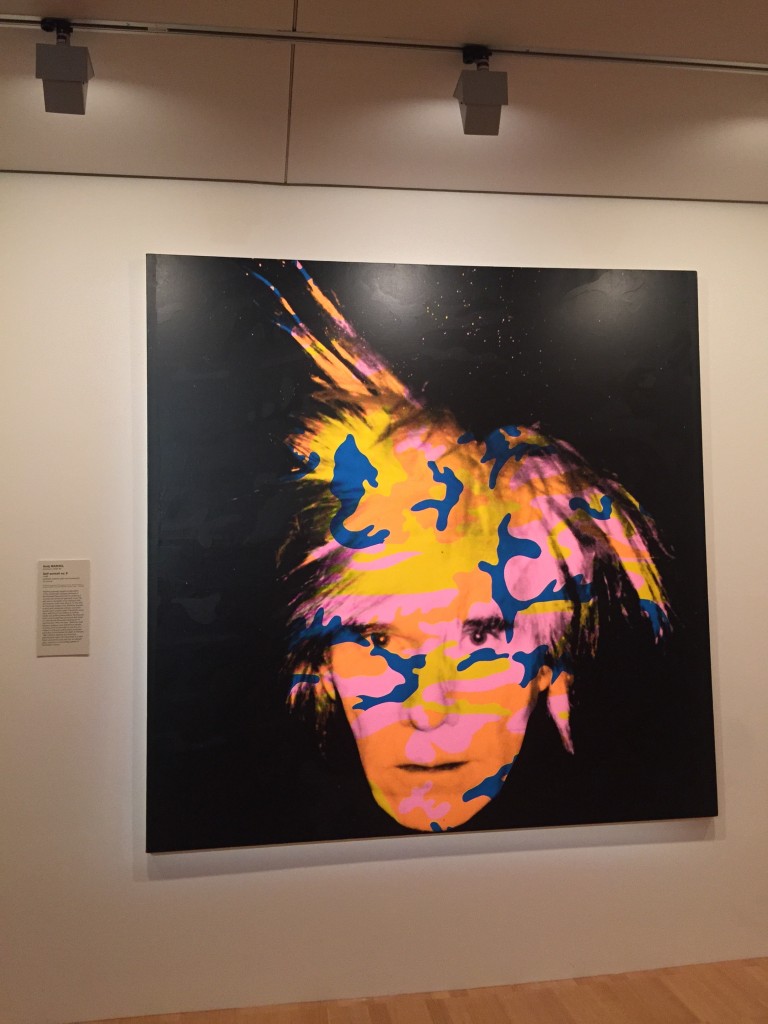A trip to the National Gallery of Victoria during our week 1 class of my new studio, ‘On The Frame’ allowed us to look at different artwork (mainly focusing on paintings) and find how different elements create different meaning in each piece.
The five elements that I chose to focus on was that of colour, character, lighting, movement and mise-en-scene. Many of the paintings that caught my attention and made me want to write about were that of people (whether it be self-portraits, portraits or candid ones).
The first piece of painting that drew my attention within the first couple of minutes entering the gallery was Andy Warhol’s large and vibrant ‘Self-Portrait No.9’ from 1986. The main element that came to mind whilst looking at this painting was ‘colour‘. The flamboyant splashes of pink, yellow, blue and orange all screamed to the audience Warhol’s eccentric style and personality, showing that he successfully conveyed his identity in this self-portrait. These ideas also bring in the element of ‘character‘. The highly-eccentric colours would represent a lively and energetic mood at first look, but analysing the image further, Warhol’s death-like stare gave us the contrary, and an eerie feel haunted the artwork. Not to mention this was created months before his death! Was this some sort of foreseeable future for Warhol?
 The second artwork was the mysterious painting done by David Hockney in 1963, titled ‘The Second Marriage’. This piece stood out the most to me because although marriage is supposed to be correlated with joy, excitement and new opportunities, the first reaction you get from Hockney’s painting is a sense of dread, gloom and boredom. The element of ‘character‘ is shown through the faces of the bride and groom. The colours on their faces are grey, pale and deathlike, conveying a dull and ghostlike mood with their emotionless expressions. The colourful mise-en-scene (couch, curtains, carpet, etc) contrasts heavily with the characters in the painting. This can be seen symbolically; the bride and groom trying to trick the outside world with bright and happy “props” and “features” in their house, hiding the reality of their unhappy marriage. Another factor that emphasises this idea of it being “all for show” is how the painting is framed. The box-like cut of the painting looks like a television set; giving a sense of entrapment and being forced to do what they are doing (forced marriage?). There is a constant feel of uncomfortableness between both characters and in the entire painting itself.
The second artwork was the mysterious painting done by David Hockney in 1963, titled ‘The Second Marriage’. This piece stood out the most to me because although marriage is supposed to be correlated with joy, excitement and new opportunities, the first reaction you get from Hockney’s painting is a sense of dread, gloom and boredom. The element of ‘character‘ is shown through the faces of the bride and groom. The colours on their faces are grey, pale and deathlike, conveying a dull and ghostlike mood with their emotionless expressions. The colourful mise-en-scene (couch, curtains, carpet, etc) contrasts heavily with the characters in the painting. This can be seen symbolically; the bride and groom trying to trick the outside world with bright and happy “props” and “features” in their house, hiding the reality of their unhappy marriage. Another factor that emphasises this idea of it being “all for show” is how the painting is framed. The box-like cut of the painting looks like a television set; giving a sense of entrapment and being forced to do what they are doing (forced marriage?). There is a constant feel of uncomfortableness between both characters and in the entire painting itself.
 The third piece was by Weaver Hawkins titled ‘Jitterbugs’, made at the end of World War II in 1945. It shows two girls and two soldiers dancing, emphasising on the element of ‘movement‘. This style of surrealist painting can be used to convey how crazy and messy war is; how there was no real meaning and point for so much death, violence and trauma. The denotations of the painting itself expresses a sense of joy and exitement; celebrating the end of war, with bright colours such as red, green, light blue and purple. The different lines and cuts within the picture make the audience feel the type of hazy, fast-paced atmosphere the dancers would be feeling.
The third piece was by Weaver Hawkins titled ‘Jitterbugs’, made at the end of World War II in 1945. It shows two girls and two soldiers dancing, emphasising on the element of ‘movement‘. This style of surrealist painting can be used to convey how crazy and messy war is; how there was no real meaning and point for so much death, violence and trauma. The denotations of the painting itself expresses a sense of joy and exitement; celebrating the end of war, with bright colours such as red, green, light blue and purple. The different lines and cuts within the picture make the audience feel the type of hazy, fast-paced atmosphere the dancers would be feeling.
